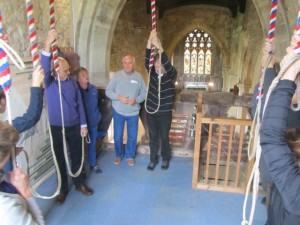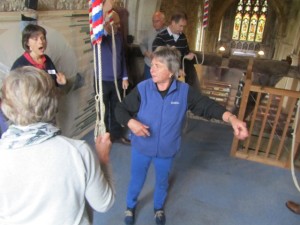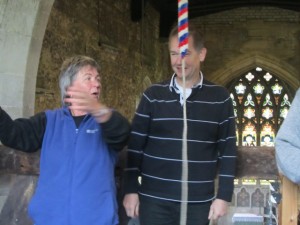Saturday 15th August 2015
 Six churches, each with an interesting history, encouraged about twenty of us to forego a lie-in to meet up at St Clement Danes for a 9.30 a.m. start. A few ringers from Rickmansworth joined us for the day which meant there were enough to allow us time to look around each church and listen to the bells outside in the sunshine, if we wanted.
Six churches, each with an interesting history, encouraged about twenty of us to forego a lie-in to meet up at St Clement Danes for a 9.30 a.m. start. A few ringers from Rickmansworth joined us for the day which meant there were enough to allow us time to look around each church and listen to the bells outside in the sunshine, if we wanted.
The 21 cwt ring of 10 at St Clement’s were a joy to ring and made an encouraging start for the more nervous among us, while there was plenty to look at in the church, as it is the Central Church of the RAF. There was also an interesting leaflet on the ‘Oranges and Lemons’ nursery rhyme which said it dates back to at least 1744. It suggests the macabre ending refers to the bells tolling as prisoners were escorted through the streets, by lantern-light, to the executioner’s axe.
Every church we rang at was rebuilt by Sir Christopher Wren after the Great Fire, though many had to be restored or rebuilt after WWII. Our second church was St James Garlickhythe, otherwise known as Wren’s Lantern. It was a surprise, therefore, to walk into an extremely gloomy wood-panelled narthex and eventually find our way up a wooden staircase into a small ringing room. A large area was boxed off, but atop this was a splendid peal board giving the details of the peal rung on the 9 cwt 8 as they travelled down the Thames on a barge during the Queen’s Diamond Jubilee celebrations. Those who went into the nave will have seen the large arched windows which gave the church its nickname. There was also decoration in the form of vine leaves, as it is the church of the Vintners Association.
We had an early break for lunch, pubs, picnics and pavement cafes proving popular!
A short walk took us to St Vedast, another tower with large arched windows and many 8-lined poems on the walls in the triolet form: rhymed ab aa abab, lines 4 and 7 repeating 1 and 8 repeating 2. The structure seemed to give them a hypnotic quality similar to the sound of the bells. A special effort to learn St Vedast Doubles had been made by some and a couple of courses were rung.
The bells of St Lawrence Jewry, on one side of Guildhall Square, are described as the best 8 in the City. We gathered outside, around a fishpond, watching goldfish swimming, honeybees drinking and people in sackcloth preparing their stalls in the square, behind some stadium seating the other side of crowd-control barriers. We were told they were going to film a contest of gladiators called Gladiator Games. It turned out our entrance to the church was behind the barriers, so Graham sweet-talked the burly security men into letting us through on the strict understanding that the bells would be silent by 3 p.m. (the end of our time slot) as that was when filming would start. The bells were cast by Whitechapel, a 24 cwt 8, and hopefully the crowd enjoyed them as much as we did.
Another short walk to Bow left us with time to watch the late arrivals at the wedding which had to end before we could access the ringing room, up another long spiral staircase. The expected large room had two large windows, each with a door. One led to a balcony overlooking the street, the other led out through plants onto a garden path, which seemed bizarre – how many other church towers have a roof garden attached to them? Sadly it was marked ‘Private’ so we couldn’t see what it was like to sit in your garden with the top of a church tower at the end of it. Somehow I think they probably retire indoors when the bells ring.
The 12 bells were suitably impressive and many of us pleased just to ring some decent rounds, though we were all encouraged to try plain hunt on 11. Although not the ‘great bell of Bow’ of the nursery rhyme, the tenor is still 41 cwt and lightly set a challenge too far for most of us. Of those who did attempt it, one in particular provided the usual entertainment (known to all sympathetic ringers) derived from someone struggling to set their bell. While it was fun to go out on the balcony and watch the construction workers in the office block opposite watching the bride and groom who were having the benefit of the bells, sadly the sound of the bells for us was distorted by the reflection off the surrounding buildings.
Our final church was due to be St Olave’s, Samuel Pepys’s resting place and the only medieval church of the day. We passed some impressive modern buildings on the way, including the car-melting ‘Walkie Talkie’ tower and arrived to find an embarrassed key-holder holding the wrong key the padlock had been changed without his knowledge. As he was unable to contact any other key-holder, we called it a day; some disappeared to find food, others to catch an early train home.
So ended a brilliant day out a great selection of towers, perfect leave-your-coat-and-brolly-at-home weather, easy navigation (just follow someone with a satnav!) and even the lock-out was the last tower.
Thank you Graham Bartholomew!
 On Saturday October 17th the North Bucks Branch held their annual training day, learning about ringing doubles variations, an area that can often be overlooked at tower practices. Personally this was a new experience as I am used to ringing triples and major methods. It felt very different.
On Saturday October 17th the North Bucks Branch held their annual training day, learning about ringing doubles variations, an area that can often be overlooked at tower practices. Personally this was a new experience as I am used to ringing triples and major methods. It felt very different.


 Held at All Saints’ Marsworth – Saturday 17th October 2015
Held at All Saints’ Marsworth – Saturday 17th October 2015


 Can you believe it has now been 3½ years since the Big Ring Pull project delivered it’s recruitment drive in Middleton Hall Milton Keynes. The BRP was a great success we still have two towers where the bells were silent before the BRP that are now regularly rung and 20 of the 42 people who attended the intensive 2 week training course in Newport Pagnell have continued to ring and are progressing well with their ringing development.
Can you believe it has now been 3½ years since the Big Ring Pull project delivered it’s recruitment drive in Middleton Hall Milton Keynes. The BRP was a great success we still have two towers where the bells were silent before the BRP that are now regularly rung and 20 of the 42 people who attended the intensive 2 week training course in Newport Pagnell have continued to ring and are progressing well with their ringing development.